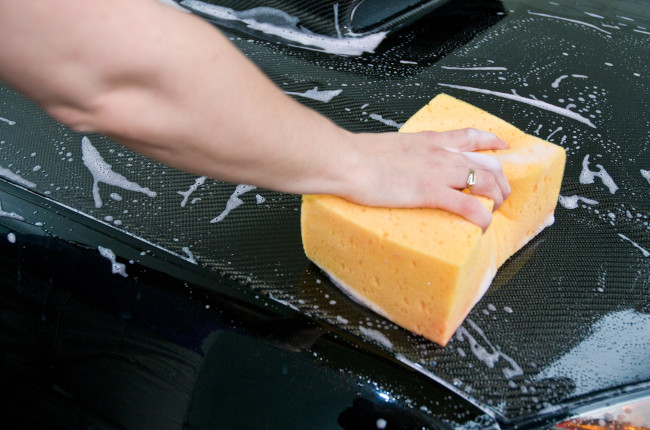
Swirl marks or micro-scratches can occur on your car’s paint over time. These marks are caused by tiny particles that are harder than your car’s clear coat. Particles like sand or silica can find themselves on your car’s paint and you might inadvertently dust them off and leave a couple of small scratches on your paint. Proper washing, as part of general vehicle maintenance, and involves a few steps and pointers in order to keep your car running and looking great.
Do not touch the paint

If there is a thin film of dust or dirt on the top of your car’s paint, do not touch it while it’s dry or even while it’s wet. The problem with dust or dirt is that it could contain mineral content that could scratch up the surface of your car’s topcoat or clearcoat.
Usually, the clearcoat on a car’s paint job is about a 6 or a bit more on the Mohs scale of hardness, while silica, sand, or glass happens to be at around 7 on the scale. When you scratch up a softer surface with a harder particle, the softer surface will get scratched and cause those dreaded marks. Also, make sure that you don’t keep your car dirty for long periods of time as dust and other debris can embed themselves into your paint’s top layer.
Gather the right tools and equipment

First, you will need a proper car shampoo. This will act as a lubricant and carry away the dust and debris on the surface of your paint.
Second, you will need a microfiber cloth or sponge that is new, as old cloths and other rags tend to be contaminated with particles that could potentially scratch up your ride.
Third, you need to get two buckets, one to wash your microfiber cloths and sponges, and the other filled with car shampoo. This is to prevent the dust that you lifted off your car from mixing in with your shampoo solution.
Fourth, you will need a second microfiber cloth for drying. Again, the same rule applies, the cleaner the better and the newer the better. When you dry your car, make sure that the cloth that you are using is a fresh one without any contaminants as you can never be too sure.
Also, make sure that you have a good amount of running water so that you don't end up dry-wiping the paint of your vehicle.
Use the proper technique

The only logical way to avoid swirl marks is to use vertical and horizontal strokes whenever you touch wash your car. The logic behind this is that the swirl marks are visible at any angle, while vertical or horizontal scratches are only visible at certain angles – if some dust or debris still finds a way to embed into your microfiber cloths and scratch up the surface.
So go up and down and side to side when applying shampoo or drying your car’s paint. Don’t wipe or lather in circles.
Protect

The last step is to protect your car by using a good quality wax or any other related coatings. Wax will fill in the gaps of existing scratches and marks provided they’re not deep and the was properly applied. Essentially, the wax is an extra layer of protection that the next batch of dust and debris has to go through before it gets to your car’s paint. It’s a more short-term solution, however, it is the most readily available and easily-accessible form of protection in the automotive market. To apply this, all you need to do is apply a small layer using the applicator pad supplied. Put the wax on all surfaces then let it dry for about 5 minutes. Afterward, buff it out with another microfiber cloth or a polishing pad until the surface is shiny.
If you really want to prevent your car’s paint from getting damaged, there are more permanent coating solutions such as ceramic or graphene, but these options are more expensive and will take a while to apply because there is a curing process involved. However, these paint treatments are much nicer and will last a lot longer than the traditional wax on and wax off. You will also need to seek professional help in order to get this applied to your car’s paint.
Latest Features
-
An all-electric future: The Porsche Macan Electric / Featured Article
Porsche’s Macan goes all-electric; it’s a new beast with an electrified heart, yet unmistakably Porsche in performance and spirit.
-
Which Kia should I buy? / Featured Article
We’re here to help you decide which Kia vehicle is best for you, whether it’s a sedan, crossover, or minivan.
-
Why Lynk & Co is a good option for luxury car buyers / Featured Article
Lynk & Co offers premium value for those exploring the luxury market.
Popular Articles
-
Electric Vehicles in the Philippines for under P1 million
Jerome Tresvalles · Aug 19, 2025
-
Top 3 Cars For Every Lifestyle—What Cars Are Right For You? | Behind a Desk
Caco Tirona · Apr 24, 2024
-
5 Tips to Maximize Fuel Efficiency
Jerome Tresvalles · Sep 09, 2024
-
Five driving habits that are draining your fuel tank
Jerome Tresvalles · Jun 24, 2025
-
Can engine braking harm your engine?
Jerome Tresvalles · Sep 11, 2025
-
Do electric cars even need maintenance?
Jerome Tresvalles · Oct 23, 2024
-
Best vehicles for an active outdoor lifestyle
Shaynah Miranda · Jul 25, 2024
-
How to drive different types of vehicle transmissions
May 23, 2024
-
5 easy ways to keep your car interior clean
Allysa Mae Zulueta · Nov 15, 2021
-
How to survive Metro Manila traffic
Earl Lee · Aug 16, 2022




